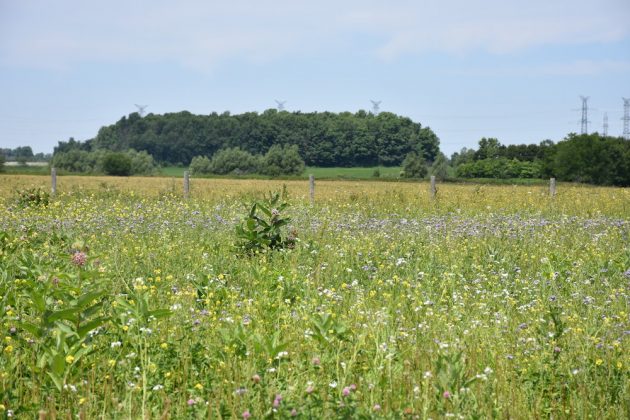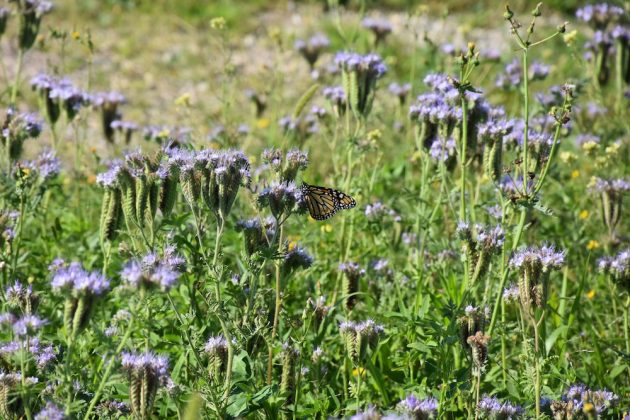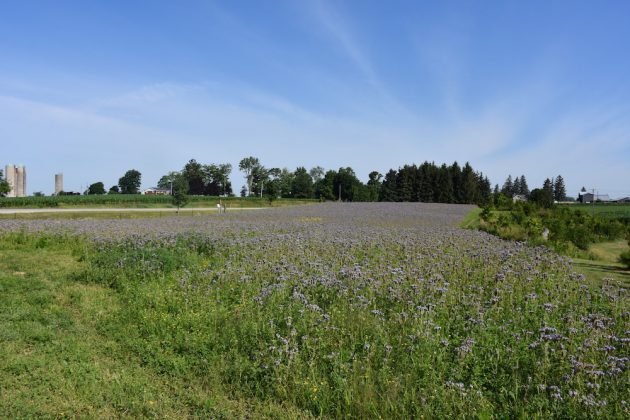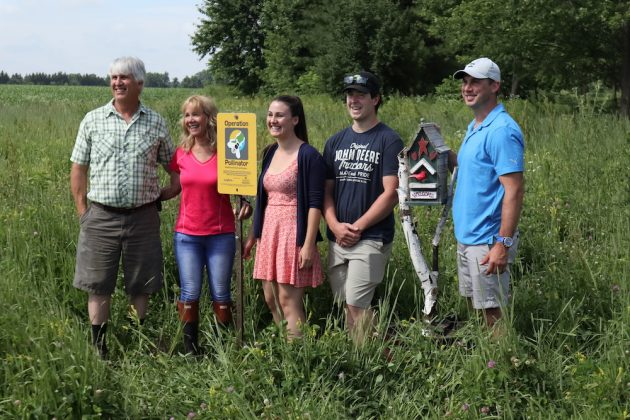
Features
Other Crops
Operation Pollinator on Ontario farms
Growers are helping bees and butterflies – and soil health, crop production, biodiversity and landscape sustainability.
August 8, 2019 By Carolyn King
 Syngenta’s preliminary research shows the Operation Pollinator’s On-Farm Program sites can make a difference in pollinator populations. Photo courtesy of Maria Ramirez Giraldo/OSCIA.
Syngenta’s preliminary research shows the Operation Pollinator’s On-Farm Program sites can make a difference in pollinator populations. Photo courtesy of Maria Ramirez Giraldo/OSCIA. A collaborative, on-farm program to help pollinators has now expanded from Western Canada into Ontario. Launched in spring 2018, the Ontario program was already fully subscribed by April for the year. With sites dotted across the province, Operation Pollinator’s On-Farm Program is creating a buzz as growers convert lower productivity areas on their farms into bee and butterfly havens.
“Operation Pollinator is a Syngenta program focused on research and partnerships to promote the health and well-being of bees and other pollinators. The program’s mandate is to support activities that enhance biodiversity, habitat and other practical initiatives that can contribute to healthy pollinator populations,” explains Paul Hoekstra, senior stewardship and policy manager with Syngenta Canada.
In Canada, Operation Pollinator includes off-farm components – such as partnerships with academic institutions and an initiative with over 60 golf courses – and its On-Farm Program.
Multiple benefits
To implement the On-Farm Program, Syngenta is partnering with the Soil Conservation Council of Canada (SCCC) and provincial delivery agents. The program’s goal is to establish and maintain pollinator-friendly habitat, study and learn from these sites, and enhance biodiversity for the benefit of the larger ecosystem.
“Research has shown that conservation efforts such as the creation of habitat are key to maintaining and increasing pollinator populations,” Hoekstra says. In agricultural landscapes, these insects pollinate many fruit, vegetable and oilseed crops, as well as plants that provide food for wildlife. In addition, pollinator habitat can also be habitat for insects that are natural enemies of crop pests.
“To enrol in the program, growers agree to convert one to two acres of land that they consider to be of lower productivity to a dedicated Operation Pollinator site,” he explains. “They are provided with a commercial-grade seed mix that supports habitat and forage for bees and other pollinators. And the growers are given some agronomic information, some small financial assistance to support site preparation and maintenance, and signage for the site.”
The seed mix is tailored to provide high-quality nutrition to pollinators. It is mainly composed of long-flowering perennial plants so the sites offer an ongoing source of pollen and nectar. As well, the mix is designed to enhance soil health; it provides cover to prevent soil erosion, adds organic matter to the soil, and feeds the soil microbial community. For instance, the mix includes legumes, which not only fix their own nitrogen but also have protein-dense pollen that helps in bee development.
Hoekstra notes, “It takes a number of years for the sites to become fully established so we are encouraging farmers to work with our provincial partners to help ensure these areas are maintained for this purpose.”
SCCC partnered with Syngenta for the On-Farm Program because it aligned with their mandate of soil health and conservation. “The program targets lands that are less desirable for regular crop production, and those lands usually need more protection from erosion. There is also a benefit in terms of removing carbon from the atmosphere,” SCCC executive director Jim Tokarchuk explains.
“The program struck us as being really consistent with improving and sustaining the agricultural landscape. In our view, the agricultural landscape is not just about raising livestock and crops. Many other people and many other species use that same landscape. This program really brings in a lot of other aspects of use on the landscape.”

Thompson’s Operation Pollinator site shows the diversity of plant species in the seed mix, including milkweed for monarch butterflies. Photo courtesy of Maria Ramirez Giraldo/OSCIA.
First the West, now Ontario
Operation Pollinator’s On-Farm Program was launched in Western Canada in April 2017. The provincial delivery partners, which helped sign up participants, were the Agriculture Research and Extension Council of Alberta, Saskatchewan Soil Conservation Association and Manitoba Conservation Districts Association.
“We’re very pleased with the strong interest and uptake in the program,” Hoekstra says. “The response has been extremely positive with great feedback. The program was fully enrolled, with 100 farmers in Western Canada: 38 in Alberta, 28 in Saskatchewan and 34 in Manitoba.”
Tokarchuk notes, “Weather-wise, the program in Western Canada has had some challenges.
“A number of places on the Prairies in the last couple of years have been very dry, so a few sites had difficulty establishing the plant stand. But we had very good results in most of the Prairies. We have seen some really brilliant examples of ravishing stands of flowers.”
The Ontario delivery partner is the Ontario Soil and Crop Improvement Association (OSCIA). “Syngenta approached OSCIA to work on Operation Pollinator because of our vast network of member producers and our experience in cost-shared program delivery across the province,” explains Angela Straathof, OSCIA program director.
“And we saw the opportunity to bring more environmentally focused education and research opportunities to Ontario producers. This is also an opportunity to work with SCCC and Syngenta, and to expand our program repertoire into experience with pollinators. Producers and the public are becoming increasingly curious about the risks and risk mitigation for pollinators.”
The Ontario participants come from a wide range of commodity groups. In 2018, the program enrolled 31 producers, a few of whom had more than one site. The 33 sites encompassed a total of 50 acres. Despite the dry summer, many of the sites had good germination and growth.
Syngenta and OSCIA are continuing the Ontario program in 2019, with 20 new producers and 34 additional acres enrolled.
OSCIA got helpful feedback from the 2018 participants on how to improve the program for 2019. For example, some growers asked for more information on seeding and site preparation. Also, the seed mix shipments were delivered in May or June, and some growers with the later deliveries had difficulty getting good germination, given the dry conditions. A few of the growers decided to wait until 2019 to plant their seed mix on their site.
So, in 2019 OSCIA will be sending out the seed shipments a bit earlier, and those shipments will include more information on seedbed preparation and seeding rates.
Straathof adds, “The most exciting change for 2019 is that we’ll have a 100 per cent Ontario native seed mix that will also emphasize monarch butterfly breeding. This will be provided in partnership with St. Williams Nursery and the Pollinator Partnership.”
For producers who participate in Operation Pollinator, she sees both direct and indirect benefits, including the seed mix, the $100/acre payment to help offset site establishment costs, and the potential for greater crop pollination.
Tokarchuk points to another direct benefit: “The program has also allowed some producers to take some less productive land out of production, which has lowered their costs a little or reduced other problems. For instance, some of the sites are odd-shaped areas where it is difficult to turn machinery or where equipment gets stuck.”
However, he says, “I think the biggest benefit that I saw as I visited some of the farms is a pride of stewardship in many participants. The program has helped foster the stewardship ethic that so many farmers across Canada have.”

Phacelia is one of the many pollinator-friendly plants in the seed mix that the Hutchesons grew. Photo courtesy of Maria Ramirez Giraldo/OSCIA.
A better cover crop in Grand Valley
“On our farm every year we plant cover crops. So when we learned about Operation Pollinator, we thought this would be a great opportunity for us to do what we were going to do anyway but would have the added benefit of providing habitat for bees and helping the bee and butterfly populations,” says Stacy Thompson.
On the Thompsons’ farm, which is in Grand Valley, they grow corn, soybeans, winter wheat and alfalfa, plus a cover crop. They also do some custom meat packages for a small clientele base.
One of her responsibilities on the farm is to look after a 6-acre field for vegetable production. Each year, she plants vegetables on 2 acres and a cover crop on the other 4 acres. In 2018, she planted 2 acres of the cover crop area to the pollinator seed mix. Those 2 acres are next to the banks of the Grand River, which runs through their farm.
“Initially, I thought the seed mix was going to be a bunch of different flowers, but in fact it was clovers and different types of grasses. So I didn’t think it was going to be anything too magnificent. But I drove down there one day with the ATV, and it was just amazing – I could not believe how many bees and butterflies were there!” she says.
Thompson has really enjoyed taking part in the program. She hopes it will continue so other farmers can participate.
A honey of a site near Ingersoll
“I saw the ad in the paper about Operation Pollinator, and I had a little chunk of land that was kind of a nuisance to get to, and my daughter and my grandson had beehives right beside it. So I thought it would be a good thing for both of them,” explains Bryan Hutcheson, who grows corn and soybeans on his farm north of Ingersoll.
First, Hutcheson made sure the site was properly prepared. “It was a family effort and it was well worthwhile.” He worked the soil a couple of times, then his daughter and granddaughter picked all the rocks off, and he rolled the soil. He hired someone to plant the seed mix because he didn’t have the right equipment.
“I had it planted on about May 3 or 4, so we had a good catch of clover and phacelia. It grew well and looked nice, and all the neighbours wondered what the heck the phacelia was – it’s a purple flower with a nice, sweet smell,” he notes. The Hutchesons live just a mile from town on a main road so the pollinator site was noticed by lots of people and made great conversation for both rural and town people discussing bees.
“When they harvested the honey this fall, you could almost taste the phacelia, with the fragrance of it in the honey. It’s a real nice, light honey with a good flavour,” he says. They cut the site for hay at the end of September, and he is anticipating a good crop again in the spring.
Hutcheson adds, “I’d like to see them continue the program if at all possible. I think it’s got potential, and it kept the neighbours interested in what was going on. I had a couple of other people asking me about it, so I told them about the program.”

The Hutchesons’ Operation Pollinator site, with its beautiful purple-flowered phacelia, attracted the interest of neighbours. Photo courtesy of Maria Ramirez Giraldo/OSCIA.
Making a difference
“We could probably have had many, many more sites across Canada, but we wanted to establish beachheads, so to speak – people who were committed and motivated. We were after the dedicated few who would keep this program alive in their local areas. I think we’ve been pretty successful doing that,” Tokarchuk says.
He adds, “After nearly 40 years in this business, I know that those kinds of producer-to-producer conversations are often the most effective way of getting a message delivered.”
Syngenta wants to see whether the program is making a difference to pollinator populations so it initiated a multi-year monitoring program in Western Canada in 2018. The company is working with biologists who specialize in projects like conducting nature surveys and ecological monitoring. They waited until 2018 to start the study so the plant cover on the sites would have more time to develop and mature.
They monitored 15 Operation Pollinator sites across the three Prairie provinces to assess the effects of the sites with respect to insect diversity and abundance. Although 2018 was just the first year of the study, Hoekstra is encouraged by the results so far.
He highlights some of the initial findings: “We found that the Operation Pollinator sites have had a positive effect on the number and diversity of bees and butterflies compared to the control locations. For example, we have seen two to three times the number of bees and butterflies in the Operation Pollinator sites compared to the control areas.”
He adds, “One really interesting finding was that two species of interest – the monarch butterfly in Manitoba and the yellow-banded bumblebee in Alberta – were only found in Operation Pollinator sites and not in the control sites during the monitoring period.”
Syngenta would like to study the effects over time as the pollinator sites further mature, so they will be monitoring again in 2019. Then they will evaluate whether to continue the study in 2020.
“By focusing on creating natural areas for bees and other pollinating insects, Operation Pollinator offers a practical and meaningful way to improve biodiversity on the farm and to refocus lower productivity land towards the establishment of habitat for bees and pollinating insects,” Hoekstra says.
“One of the major things we’ve seen from the program is that there is a tremendous appetite in the farming community in the area of biodiversity and the health of bees and other pollinators.
“The program has brought together individual farmers and organizations that are interested in creating habitat on the farm for pollinators and other wildlife.”
He emphasizes, “Operation Pollinator’s On-Farm Program really has been successful because of our partnerships with SCCC, the provincial delivery agents and, of course, the farmers themselves.”
2019 bus tour
To showcase a few of these successful sites, Syngenta, SCCC and OSCIA organized an Operation Pollinator Tour Day on July 3, 2019. The bus tour visited the three sites in Thorndale, Ingersoll and Wilsonville. Samantha Lyon, OSCIA programs analyst, recounted how the day was a great success with many folks passionate about pollinators and curious about the program in attendance, including visitors from Manitoba representing Ducks Unlimited Canada and Soil Conservation Council of Canada. She added that the Syngenta-sponsored tour was also filled with enthusiasm from the three engaging producers.
